It is hard to imagine a world without electricity. At one time, electricity was a humble offering, providing humanity with unnatural light that did not depend on gas lamps or kerosene lanterns. Today, it has grown to become the basis of our comfort, providing our heat, lighting and climate control, and powering all of our appliances, be they for cooking, cleaning, or entertainment. And beneath most of the machines that make it possible is a simple law known as Electromagnetic Induction, a law which describes the operation of generators, electric motors, transformers, induction motors, synchronous motors, solenoids, and most other electrical machines. Scientifically speaking it refers to the production of voltage across a conductor (a wire or similar piece of conducting material) that is moving through a magnetic field.
Though many people have been thought to have contributed to the discovery of this phenomenon, it is Michael Faraday who is credited with first making the discovery in 1831. Known as Faraday’s law, it states that “The induced electromotive force (EMF) in any closed circuit is equal to the time rate of change of the magnetic flux through the circuit”. In practice, this means that an electric current will be induced in any closed circuit when the magnetic flux (i.e. the amount of magnetic field) passing through a surface bounded by the conductor changes. This applies whether the field itself changes in strength or the conductor is moved through it.
Whereas it was already known at this time that an electric current produced a magnetic field, Faraday demonstrated that the reverse was also true. In short, he proved that one could generate an electric current by passing a wire through a magnetic field. To test this hypothesis, Faraday wrapped a piece of metal wire around a paper cylinder and then connected the coil to a galvanometer (a device used to measure electric current). He then moved a magnet back and forth inside the cylinder and recorded through the galvanometer that an electrical current was being induced in the wire. He confirmed from this that a moving magnetic field was necessary to induce an electrical field, because when the magnet stopped moving, the current also ceased.
Today, electromagnetic induction is used to power many electrical devices. One of the most widely known uses is in electrical generators (such as hydroelectric dams) where mechanical power is used to move a magnetic field past coils of wire to generate voltage.
In mathematical form, Faraday’s law states that: ? = – d?B/dt, where ? is the electromotive force and ?B is the magnetic flux, and d and t represent distance and time.
We have written many articles about electromagnetic induction for Universe Today. Here’s an article about electromagnets, and here’s an article about generators.
If you’d like more info on electromagnetic induction, check out these articles from All About Circuits and Physics 24/7.
We’ve also recorded an entire episode of Astronomy Cast all about Electromagnetism. Listen here, Episode 103: Electromagnetism.
Sources:
http://en.wikipedia.org/wiki/Electromagnetic_induction
http://en.wikipedia.org/wiki/Faraday%27s_law_of_induction
http://en.wikipedia.org/wiki/Magnetic_flux
http://micro.magnet.fsu.edu/electromag/java/faraday2/
http://www.scienceclarified.com/El-Ex/Electromagnetic-Induction.html
http://en.wikipedia.org/wiki/Galvanometer

